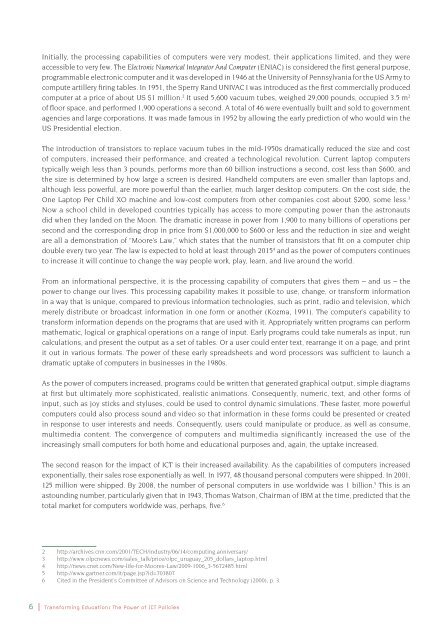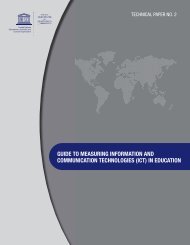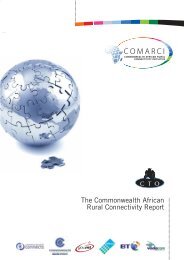Transforming education: the power of ICT policies - Commonwealth ...
Transforming education: the power of ICT policies - Commonwealth ...
Transforming education: the power of ICT policies - Commonwealth ...
You also want an ePaper? Increase the reach of your titles
YUMPU automatically turns print PDFs into web optimized ePapers that Google loves.
Initially, <strong>the</strong> processing capabilities <strong>of</strong> computers were very modest, <strong>the</strong>ir applications limited, and <strong>the</strong>y were<br />
accessible to very few. The Electronic Numerical Integrator And Computer (ENIAC) is considered <strong>the</strong> fi rst general purpose,<br />
programmable electronic computer and it was developed in 1946 at <strong>the</strong> University <strong>of</strong> Pennsylvania for <strong>the</strong> US Army to<br />
compute artillery fi ring tables. In 1951, <strong>the</strong> Sperry Rand UNIVAC I was introduced as <strong>the</strong> fi rst commercially produced<br />
computer at a price <strong>of</strong> about US $1 million. 2 It used 5,600 vacuum tubes, weighed 29,000 pounds, occupied 3.5 m 2<br />
<strong>of</strong> fl oor space, and performed 1,900 operations a second. A total <strong>of</strong> 46 were eventually built and sold to government<br />
agencies and large corporations. It was made famous in 1952 by allowing <strong>the</strong> early prediction <strong>of</strong> who would win <strong>the</strong><br />
US Presidential election.<br />
The introduction <strong>of</strong> transistors to replace vacuum tubes in <strong>the</strong> mid-1950s dramatically reduced <strong>the</strong> size and cost<br />
<strong>of</strong> computers, increased <strong>the</strong>ir performance, and created a technological revolution. Current laptop computers<br />
typically weigh less than 3 pounds, performs more than 60 billion instructions a second, cost less than $600, and<br />
<strong>the</strong> size is determined by how large a screen is desired. Handheld computers are even smaller than laptops and,<br />
although less <strong>power</strong>ful, are more <strong>power</strong>ful than <strong>the</strong> earlier, much larger desktop computers. On <strong>the</strong> cost side, <strong>the</strong><br />
One Laptop Per Child XO machine and low-cost computers from o<strong>the</strong>r companies cost about $200, some less. 3<br />
Now a school child in developed countries typically has access to more computing <strong>power</strong> than <strong>the</strong> astronauts<br />
did when <strong>the</strong>y landed on <strong>the</strong> Moon. The dramatic increase in <strong>power</strong> from 1,900 to many billions <strong>of</strong> operations per<br />
second and <strong>the</strong> corresponding drop in price from $1,000,000 to $600 or less and <strong>the</strong> reduction in size and weight<br />
are all a demonstration <strong>of</strong> “Moore’s Law,” which states that <strong>the</strong> number <strong>of</strong> transistors that fi t on a computer chip<br />
double every two year. The law is expected to hold at least through 2015 4 and as <strong>the</strong> <strong>power</strong> <strong>of</strong> computers continues<br />
to increase it will continue to change <strong>the</strong> way people work, play, learn, and live around <strong>the</strong> world.<br />
From an informational perspective, it is <strong>the</strong> processing capability <strong>of</strong> computers that gives <strong>the</strong>m – and us – <strong>the</strong><br />
<strong>power</strong> to change our lives. This processing capability makes it possible to use, change, or transform information<br />
in a way that is unique, compared to previous information technologies, such as print, radio and television, which<br />
merely distribute or broadcast information in one form or ano<strong>the</strong>r (Kozma, 1991). The computer’s capability to<br />
transform information depends on <strong>the</strong> programs that are used with it. Appropriately written programs can perform<br />
ma<strong>the</strong>matic, logical or graphical operations on a range <strong>of</strong> input. Early programs could take numerals as input, run<br />
calculations, and present <strong>the</strong> output as a set <strong>of</strong> tables. Or a user could enter text, rearrange it on a page, and print<br />
it out in various formats. The <strong>power</strong> <strong>of</strong> <strong>the</strong>se early spreadsheets and word processors was suffi cient to launch a<br />
dramatic uptake <strong>of</strong> computers in businesses in <strong>the</strong> 1980s.<br />
As <strong>the</strong> <strong>power</strong> <strong>of</strong> computers increased, programs could be written that generated graphical output, simple diagrams<br />
at fi rst but ultimately more sophisticated, realistic animations. Consequently, numeric, text, and o<strong>the</strong>r forms <strong>of</strong><br />
input, such as joy sticks and styluses, could be used to control dynamic simulations. These faster, more <strong>power</strong>ful<br />
computers could also process sound and video so that information in <strong>the</strong>se forms could be presented or created<br />
in response to user interests and needs. Consequently, users could manipulate or produce, as well as consume,<br />
multimedia content. The convergence <strong>of</strong> computers and multimedia significantly increased <strong>the</strong> use <strong>of</strong> <strong>the</strong><br />
increasingly small computers for both home and <strong>education</strong>al purposes and, again, <strong>the</strong> uptake increased.<br />
The second reason for <strong>the</strong> impact <strong>of</strong> <strong>ICT</strong> is <strong>the</strong>ir increased availability. As <strong>the</strong> capabilities <strong>of</strong> computers increased<br />
exponentially, <strong>the</strong>ir sales rose exponentially as well. In 1977, 48 thousand personal computers were shipped. In 2001,<br />
125 million were shipped. By 2008, <strong>the</strong> number <strong>of</strong> personal computers in use worldwide was 1 billion. 5 This is an<br />
astounding number, particularly given that in 1943, Thomas Watson, Chairman <strong>of</strong> IBM at <strong>the</strong> time, predicted that <strong>the</strong><br />
total market for computers worldwide was, perhaps, fi ve. 6<br />
2 http://archives.cnn.com/2001/TECH/industry/06/14/computing.anniversary/<br />
3 http://www.olpcnews.com/sales_talk/price/olpc_uruguay_205_dollars_laptop.html<br />
4 http://news.cnet.com/New-life-for-Moores-Law/2009-1006_3-5672485.html<br />
5 http://www.gartner.com/it/page.jsp?id=703807<br />
6 Cited in <strong>the</strong> President’s Committee <strong>of</strong> Advisors on Science and Technology (2000), p. 3.<br />
6 | <strong>Transforming</strong> Education: The Power <strong>of</strong> <strong>ICT</strong> Policies
















